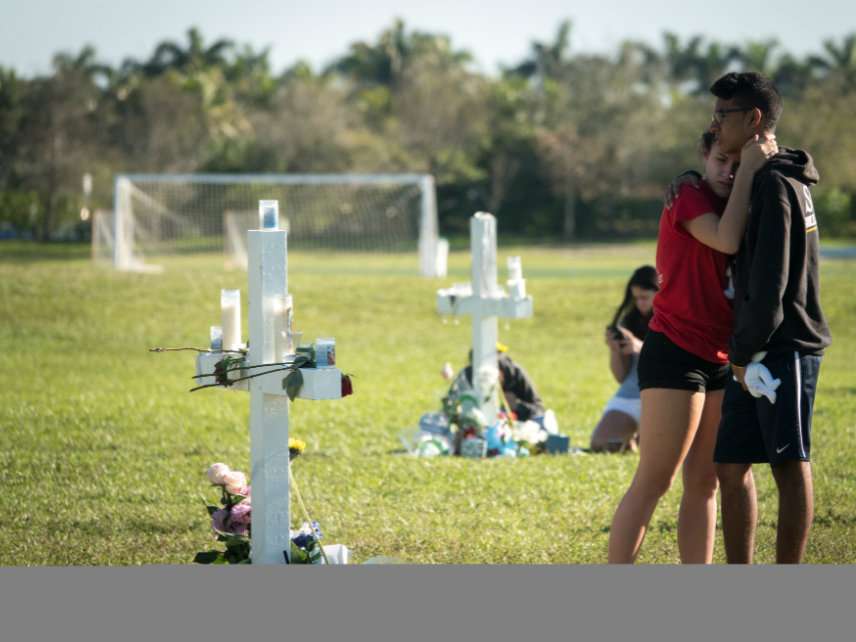Searching for Gun Violence Solutions That Don't Collectivize Punishment
Are "gun violence restraining orders" the answer?

Former Virginia Gov. Terry McAuliffe, a Democrat, and David French, a senior editor at the conservative National Review, probably differ on most domestic-policy issues. But on one particular gun-control measure, they clearly agree.
French wrote about the measure last week, in the wake of the heinous school massacre in Parkland, Florida. McAuliffe pitched the idea with regard to domestic abusers two and a half years ago in a news conference. They're both right.
It's called a gun violence restraining order (GVRO), or sometimes a gun violence protective order. It's based on a familiar model: the domestic restraining order. As the Giffords Law Center to Prevent Gun Violence explains, GVROs "allow families and household members, as well as law enforcement officers, to petition a court to remove a person's access to guns if he or she poses an imminent danger to self or others."
The Parkland massacre makes the utility of GVROs excruciatingly obvious. The FBI now concedes that it failed to act on a tip about the shooter from someone who found the shooter's behavior, gun ownership, and social media posts disturbing. But even if the FBI had acted, it might not have been able to prevent the shooting: You can't throw somebody in jail simply for behaving erratically.
Sadly, this is not a new story:
- Seung-Hui Cho exhibited numerous warning signs before committing the massacre at Virginia Tech.
- The man who killed more than two dozen people in Sutherland Springs, Texas, had escaped from a mental facility and tried to carry out death threats, among other red flags.
- The perpetrator of the massacre at the Pulse nightclub in Orlando had a long history of troubling behavior and acted so bizarrely in a gun store that the owner said he called the FBI.
- Friends of the man who killed nine people in a black church in Charleston say he had threatened to shoot up a school the week before.
- Acquaintances of the man who killed 13 people at Fort Hood said he was a "ticking time bomb" and complained that their superior officers ignored clear warning signs.
- A Connecticut investigation found that the perpetrator of the massacre at Sandy Hook Elementary School exhibit clear "warning signs" that the school district and others "missed opportunities" to address.
Not every mass killer gives off an air of impending menace. The perpetrators of the shootings in San Bernardino and Las Vegas did not telegraph their intentions. But most mass killers often display a clear set of similar warning signs: social isolation, depression, narcissism, resentment, a sudden fascination with firearms, and so on. When an individual raises fears that he might do something horrible, a GVRO gives friends, neighbors, family, and authorities a means of preventing a nightmare.
The other advantage of GVROs, as French notes, is that they do not constitute "collective punishment."
The vast majority of gun owners in the U.S. will never hurt anyone, so they naturally bristle at the idea that they should be forced to give up their rights because a minuscule percentage of others abuse those rights. (And the percentage truly is minuscule: 73 million Americans own a firearm; 5 million Americans own an AR-15. As the Richmond-based Fourth Circuit Court has noted, "in 2012, the number of AR- and AK-style weapons manufactured and imported into the United States was more than double the number of Ford F-150 trucks sold, the most commonly sold vehicle in the United States." Yet in 2014 rifles of all types, not just assault-style rifles, accounted for fewer than 250 homicides.)
Collective punishment should offend not just gun owners, but any American who believes in individual responsibility and due process. And, in fact, liberals generally abhor the collective-punishment model when it is imposed in other circumstances or on other populations—e.g., on Middle Easterners and Muslims by policies such as the Trump travel ban.
For similar reasons, liberals also recoiled against many policies of the Bush administration, such as warrantless wiretapping and suspending the habeas corpus rights of alleged enemy combatants, imposed in the name of saving lives. Such policies were not only unconstitutional, liberals argued, they were also ineffective—precisely the points most conservatives make about gun control. (Hence it's worth noting that GVRO's raise legitimate due-process concerns, and need to be crafted carefully to minimize such concerns.)
Arguments about constitutionality and effectiveness are worth having. But Americans should not let their disagreements about other measures stand in the way of the things that (a) are constitutional, (b) would be effective, and (c) both sides can agree on.
So far fewer than half a dozen states have GVROs. Virginia considered, but defeated, a similar proposal (although the state does now require domestic abusers who have been served with a protective order to surrender their firearms). If Americans want to do something genuinely useful about mass shootings, passing GVRO legislation throughout the country seems like the obvious next step.
This column originally appeared in the Richmond Times-Dispatch.


Show Comments (159)